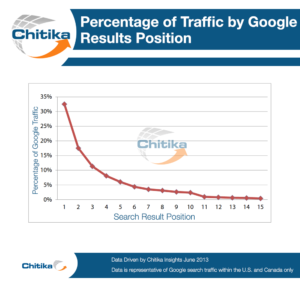The following lesson provides information on Google’s average Click Through Rates for organic and paid search listings.
What is a Click Through Rate (CTR)?
When starting an SEO campaign, it’s important to understand the average Click Through Rate (CTR%) that different positions get in Google’s organic search results. This is in order to calculate the amount of traffic you’ll receive based on the keyword traffic and your rankings.
The CTR shows the total percentage of people clicking on your results on the Search Engine Results Page (SERP). The CTR is calculated by as follows: (No. of clicks/No. of Impressions) x 100.
Therefore, if you had 5 clicks and 200 impressions, the CTR would be 2.5%.
Similar to PPC, learning the average CTR for different positions in the organic listing helps you understand where most of the traffic goes. As you’ll see in this article, it also stresses the importance of ranking 1st – 3rd or at least first page for your main key terms
Click Through Rates (CTR) based on Organic Rankings
According to a report from the online ad network Chitika.com in 2013, around 33% of searchers clicked on the first organic result in Google.com. This is followed by 18% CTR on the second result, 11% on the third result, 8% on the fourth result, 6% on thefifth result and so on.
The CTR for the first 15 results can be seen below:
Organic Position Rank and CTR% in Google.com:
- 32.5%

- 17.6`%
- 11.4%
- 8.1%
- 6.1%
- 4.4%
- 3.5%
- 3.1%
- 2.6%
- 10. 2.4%
- 11. 1.0%
- 12. 0.8%
- 13. 0.7%
- 14. 0.6%
- 15. 0.4%
Interestingly, a whopping 92% of visitors clicked on the 1st page of Google’s search results when performing a search (this data is limited to the US and Canada only).
This means that only 8% searchers bother to click pass the 1st page when performing a search result. This shows the strategic importance on getting on the first page of Google for your primary keywords.
Click Through Rates (CTR) based on Paid Results/Rankings:
In addition to organic results, Google also displays paid results for PPC advertisers at the top, side and bottom of their search results. In total, 55% of Google’s searches include paid results, therefore it’s equally important to understand the CTR for these ads.
According to a report from 2011, the ratio of users that clicked on organic results compared to paid results used to be 94%: 6%. However, as Google has introduced new ad formats and changes to how their results are presented, this ratio has drastically been reduced.
For example, a report by WordStream.com in 2012 showed that the number of clicks to Google’s paid results outnumbers the organic results by a factor of 2:1 for some commercial queries.
Paid Search Ranking and CTR%:
According to a recent report by SmartInsights.com in November 2013, the following shows the average CTR for ads on Google:
Top Ads:
- 7.11%
- 3.01%
- 2.19
Side Ads:
- 2.15%
- 1.61%
- 1.04%
- 0.89%
- 0.75%
- 0.55%
As you can see from these results, if you’re engaging in a PPC campaign then most of the paid traffic will be going to the top 3 results above the fold, however the 4th ad (top of the sidebar ads) also receives a good CTR%.
Conclusion on CTR in Google
1. Google is Increasing the CTR% of People who Click on Paid Ads
Although this data was accurate when the samples were taken, it should be pointed out that Google continues to change how their search results are displayed. For example, this article by SearchEngineWatch.com shows how Google introduced new ad formats with orange boxes in late 2013, which will inevitably have increase the CTR for ads.
You have to remember that the overall aim for Google is to increase the CTR of their paid ads, since this is where 97% of their total revenue comes from. Therefore Google will continue to introduce subtle changes that sway the click through rate of users from organic results towards paid ads.
2. CTR Varies between Different Industries
It should also be noted that the average CTR for your specific site will vary depending on the nature of the query (e.g. for brand searches the no.1 position receives a CTR of 80+%), the industry’s average click-through rates and the quality of your title tag and meta description.
For example, most people in the tech industry will avoid clicking on Adwords ads in the search results. In contrast, many mums and parents still fail to distinguish between organic and paid ads, which leads to a higher CTR% of paid ads for mums and the female market.
3. The Introduction of Universal Search, Videos and Shopping Units affects the CTR
Finally, the introduction of universal search in 2007 which includes videos, shopping results and other items in the search results will heavily effect the CTR of organic search listings. Likewise, the introduction of in-depth articles in August 2013 and the knowledge graph in May 2012 is another example of changes which will change how users engage with the search results.
